Feropods will not help: research and mathematical modeling of pit traps for ant lion larvae

The researcher, mesmerized by the grandeur and beauty of the world outside his city, wills fate in places where he had never been before. Wounded and exhausted, he seeks his way home, meeting on his way soulless and disinterested passers-by, ready to reverently watch the death of another. Not ready to put up with such social injustice, he intervenes and saves an unknown creature from the voracious jaws of a terrible monster. This creature is small, but with a big heart, offers him his help in response to salvation. And the gluttonous monster, ironically, becomes the prey of an even larger creature, before which everyone trembles without exception.
It sounds like the beginning of some Hollywood adventure movie, but in fact it is Ant's Journey (1983), a wonderful cartoon that has long been disassembled into quotes. The ant rescues the booger (“I hear from the booger!”) From a trap made by one very busy creature - the ant lion. And today we will talk specifically about them, and more precisely about how biologists, in collaboration with physicists, conducted a study of the structure of ant lion traps. Why such traps cannot be called simple pits, like the larvae of ant lions make them, and what are the exact parameters of these deadly buildings? We will find the most interesting answers to these and other questions in the report of scientists. Go.
Tools, architecture and pits of death
Scientists who decide to conduct this study argue that the use of animal tools is painfully overrated. And this statement cannot be called unreasonable. For example, chimpanzees use tools for food extraction in only 1% of cases. Buildings that various creatures use on an ongoing basis, including nests and traps for catching prey, deserve much more attention.
Making web traps is difficult, but common, but silk bridges across rivers are a completely different level of skill.
Building traps is not the most popular skill among the inhabitants of our planet. Among vertebrates, only humans possess this skill. And among invertebrates, spiders and their networks are the first to come to mind, the complexity, variety and mathematical accuracy of which are amazing. Of course, our eight-legged friends are not the only ones who use silk produced by their own bodies as building materials. In addition to 10,000 species of spiders, 2000 larvae of caddis species also use silk, as well as larvae of 4 species of Arachnocampa from the genus of mushroom mosquitoes.
But the construction of traps without the use of silk is common only among several hundred species of ant and a small number of species of worms. One of these builders is the ant lion larva.

An adult ant lion playing peepers with a photographer.
The ant lion is not a mythical chimera or the brainchild of a science fiction writer, it is a family of insects that look very much like dragonflies. But they received their non-standard name for the appearance and habits of the larvae.
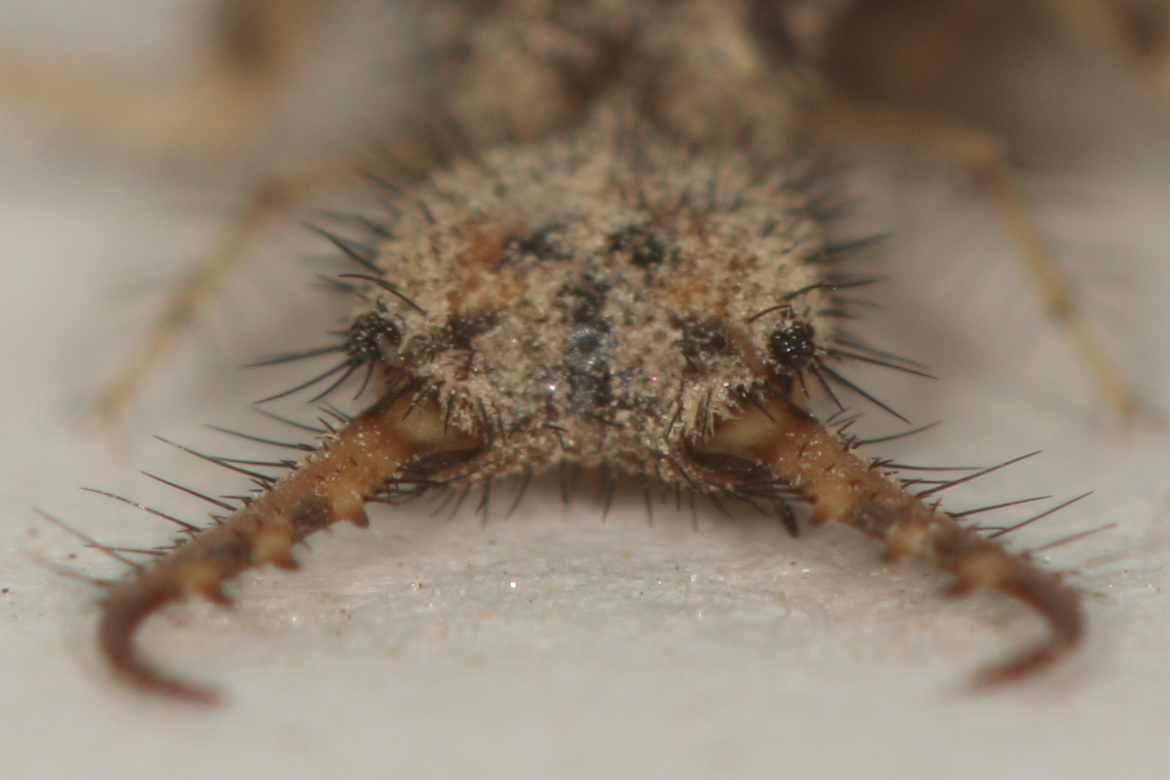
“Cute” face of an ant lion larva.
The larvae of ant lions come in two forms, depending on their behavior. Some live in the sand and chase their prey, so to speak they hunt in a classic way. Others, possessing patience and architectural skills, build pits in the sand up to 5 cm deep and about 8 cm in diameter. The larva itself is buried in the center of its trap, leaving only its massive and very strong mandibles on the surface. The victim, usually an ant, having the imprudence to step on the edge of the fossa, begins to slide down to its inevitable death. Grabbing the prey, the ant lion larva injects digestive enzymes into its body and literally drinks the victim, throwing its devastated chitin exoskeleton outside the trap.

The larva of an ant lion.
If the prey turned out to be painfully quick and energetic and tries to get out of the trap, the larva starts throwing grains of sand at it, which can knock down the victim. In the same way, literally working their heads, ant lion larvae build their traps. And it was the construction process that interested scientists. The sand is very heterogeneous and consists of sand grains (grains) of different sizes and, accordingly, weight (like snowflakes, for example). Larvae of ant lions build in a spiral, sorting grains of sand in a specific order. How and why - these are questions that scientists have decided to find answers to.
Study basis
Scientists decided to conduct observations in controlled conditions using sand grains of three specific sizes and a paper ring, necessary to determine the size of the ejected particles, the diameter of the trap and other measurements.
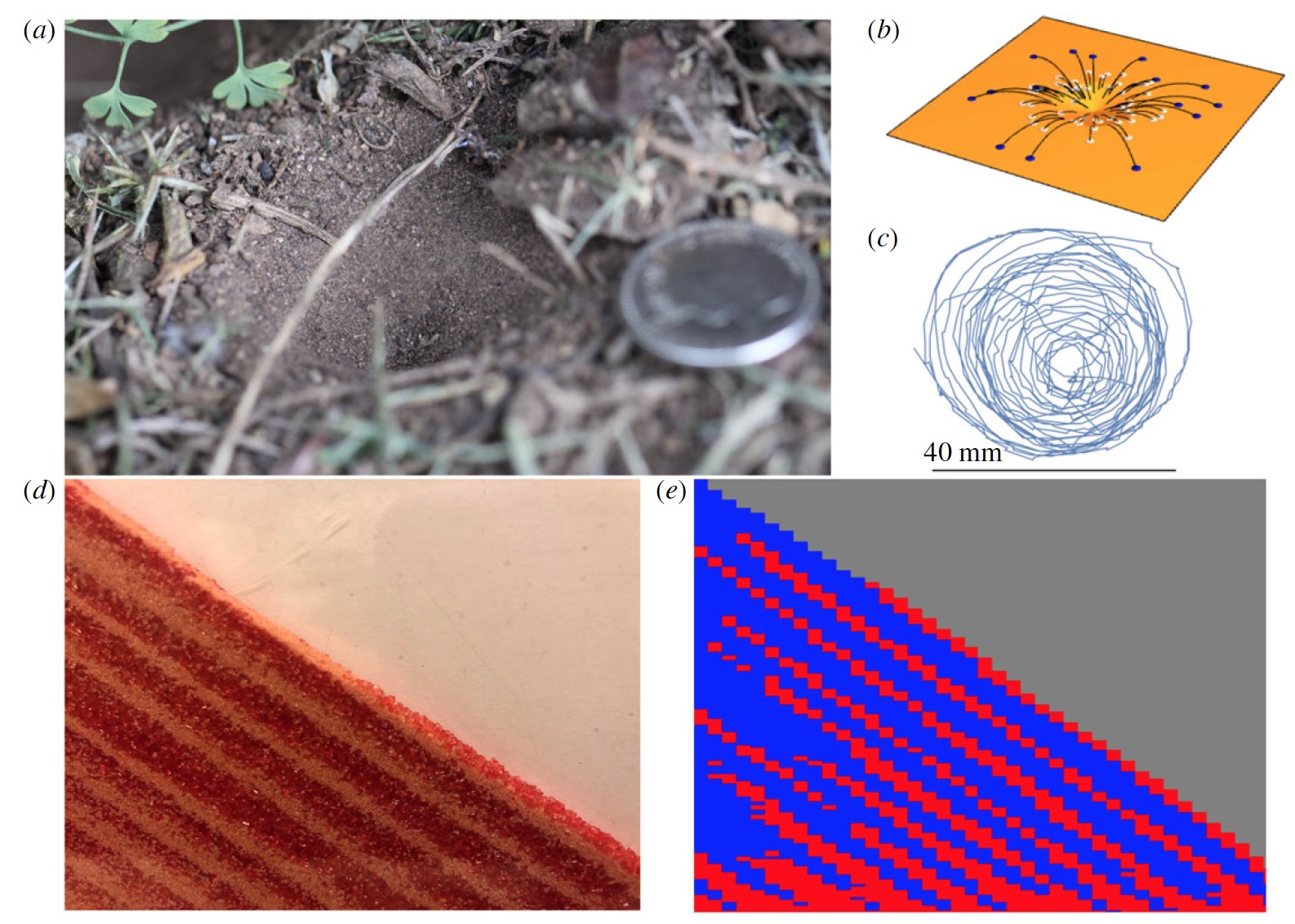
Image No. 1: а - the appearance of the trap pit of the ant lion larva (photo taken on Guernsey Island); b - image of the radius of the release of grains, depending on their size and weight; c - two-dimensional image of the spiral trajectory of the pit-trap construction: d - snapshot of the edge of the pit-trap from the experiment (we can see a clear separation / sorting of granules); e is a trap pit model that takes into account the Hele-Shaw rule.
The experimental subjects were 16 larvae of ant lions of the Euroleon nostras species, which were taken from the wild (southeast of Guernsey). Scientists note an amazing observation: the pits of these larvae were located under hedges, i.e. in shrubs, and not in open sandy spaces, as is usually the case. This is probably an attempt to use shrubs as protection against rain. In addition, scientists noticed that the larvae built traps exclusively in places where there was a minimum of debris (fallen leaves, branches, etc.). These observations alone are enough to make a preliminary conclusion about the nonrandom choice of the construction site of the trap pit.
The researchers prepared a test sand mixture of natural dry silver sand from the beaches of Guernsey, black silica grains (1-2 mm, an average of 0.0078 g) and blue silica grains (1.5-3 mm, an average of 0.028 g). Flower pots with a height of 14 cm and a depth of 12 cm were used as building sites. Each of the building components was placed in a pot in a certain order: it was based on a 7 cm layer of natural sand, then to the middle of the pot (2.5 cm from the top edge) a layer of one of 4 mixtures of 20-30% of large grains (black or blue silica) and 80-70% of natural sand. From above, everything was covered with a paper ring, necessary for measurements, with a diameter of 12.6 cm (hole - 4 cm).
All larvae were placed in the center of the flower pots. Most larvae began construction already during the first hour of observation. And after about two days, each of the larvae built itself a pit trap with a diameter of 12 to 23 mm. Scientists collected all the grains that the larvae threw out during construction (they were on a paper ring) and sifted for sorting. The location of discarded colored grains on a paper ring was noted manually by means of photographs. Scientists did not want to use automated methods in order to get more accurate results.
Observation Results
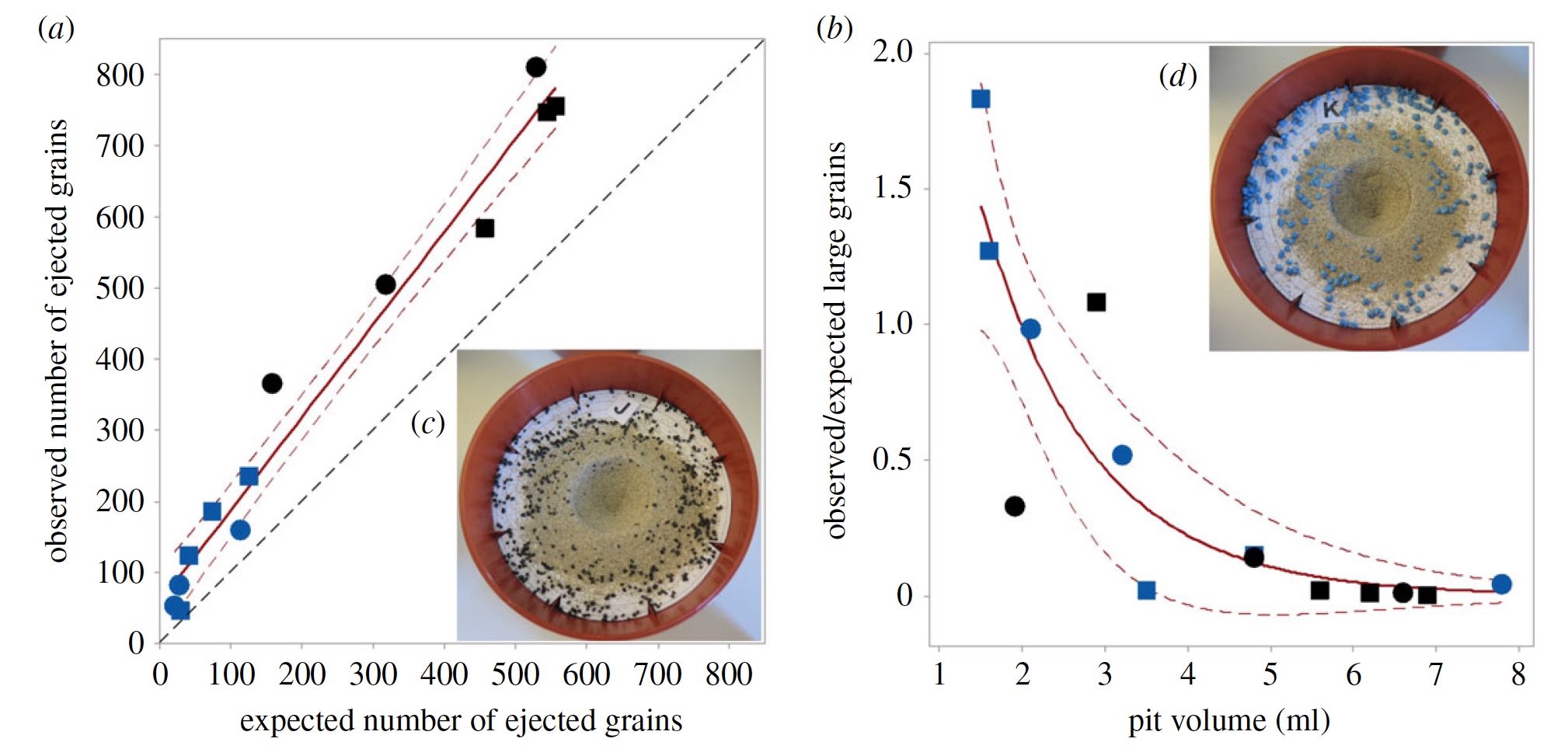
Image No. 2: laboratory observation results.
As can be seen from graph 2a, the larvae preferred to get rid of larger grains. Blue and black particles of silica were thrown out 1.3 times more than they were in the mixture. Scientists also noticed that with an increase in the size of the pit, the number of large grains in its walls decreased ( 2c and 2d ). Such an observation may be due to the fact that small pits cannot contribute to sufficient stratification. That is, the convergence of granules (like an avalanche) when a victim enters a pit is much more likely with a larger volume of the pit itself. In addition to this, smaller grains are a concomitant factor, since they have a smaller angle of repose, so slipping is more likely.
Simply put, small grains are important for ant lion larvae, because at their expense the prey will most likely slide to hungry stings, and will not get out with the words "fuh, carried through." It turns out that the larvae build pits not thoughtlessly, but quite consciously sorting building materials, ensuring maximum efficiency of the future construction.
Observations are observations, but for a complete understanding of the architecture of ant lion traps, scientists decided to see what the computational model of this building would look like.
Spiral Digging Modeling
First of all, scientists note that the larvae of ant lions do not build their traps like other "diggers" do. The process of digging occurs in a spiral, and not vertically. And mathematical modeling can reveal the secrets of this process.
In creating the model, previous work on self-organization in granular media was used. Scientists considered a mixture of small and large granules (grains) as a one-dimensional lattice with nodes i = 1,2, ..., L, representing a cross section of a real experimental well. Small particles in volume and height are 1, and large particles are 2. Thus, the height at node i, hi is calculated from the sum of small and large particles at the node, where the local slopes on each side are equal to z i Left = h i - hi-1 and z i Right = h i - h i + 1 .
A landslide will occur only if the arithmetic average of the granules of the local slope exceeds the critical mark. It is also obvious that large grains will be more stable with a steeper slope than small ones. In turn, small grains located on large ones are more stable than large ones on small ones. This condition is necessary to account for stratification in the mathematical model.
A grain can roll left / right if the local slope in the corresponding direction exceeds the critical mark, z i c . If z i Left and z i Rightexceed the critical indicator, the granule will roll in the direction of the steepest slope or in a random direction if z i Left = z i Right ﹥ z i c .
Determination of the power (size) of a landslide is the total number of pellet falls in the pit over a certain time period ( t ). As for the weight, it is determined by the size of the granules themselves: large ones contribute 2 to the total indicator, and small ones - 1. Thus, all granules that participate in the landslide are taken into account: the initial ones and those that were captured by the stream during the movement.

Image No. 3: the result of the spiral model at t = 700 and the initial radius r = 25. Small grains are marked in blue, large grains in red, and a mixture of both in white, given that large grains are not more than 25%.
In the initial state, particle models are added randomly in size while h i= H or H + 1, given the condition that 25% of the total number of grains is precisely large. The dimensions of the “removal / ejection window” were set as 5x5 (width to depth) in accordance with the fact that ant lions throw out at each step of the process of digging a hole. This "window" was centered in a specific node of the lattice, which can be shifted in accordance with the spiral path of digging. The program can throw out grains as many as desired until a stable state of the walls of the simulated pit trap is reached.
Scientists, using the Stokes approximation and Newton’s second law, derived the formula for the trajectory of the ejected particles:

v x and v y are the horizontal and vertical components of the particle velocity;
g- gravitational acceleration;
⍺ = g / v T is the shape resistance coefficient, where v T is the final particle velocity: 150 cm / s for small particles and 1000 cm / s for large.
The initial speed with which the particles are ejected is as follows: v 0 = (70 + δv) cm / s. And the direction of the throw: θ 0 = (50 + δθ) °.
The initial radius of the pit ( r ) is 25. The model carries out the digging process at each node 4 times, which ensures the helicity of removal of most of the grains. The spiral reaches the center after 8r steps, and the completion of the pit occurs when the number of large grains in the “removal window” falls below a critical level.
To understand the effectiveness of the spiral method of forming pit traps, scientists compared the above model with three models with centralized digging: a model without redistribution of grains (they are simply removed in the process), a model without resistance of grains (the trajectories of small and large grains are the same in this case), the model with considering resistance.
Simulation results
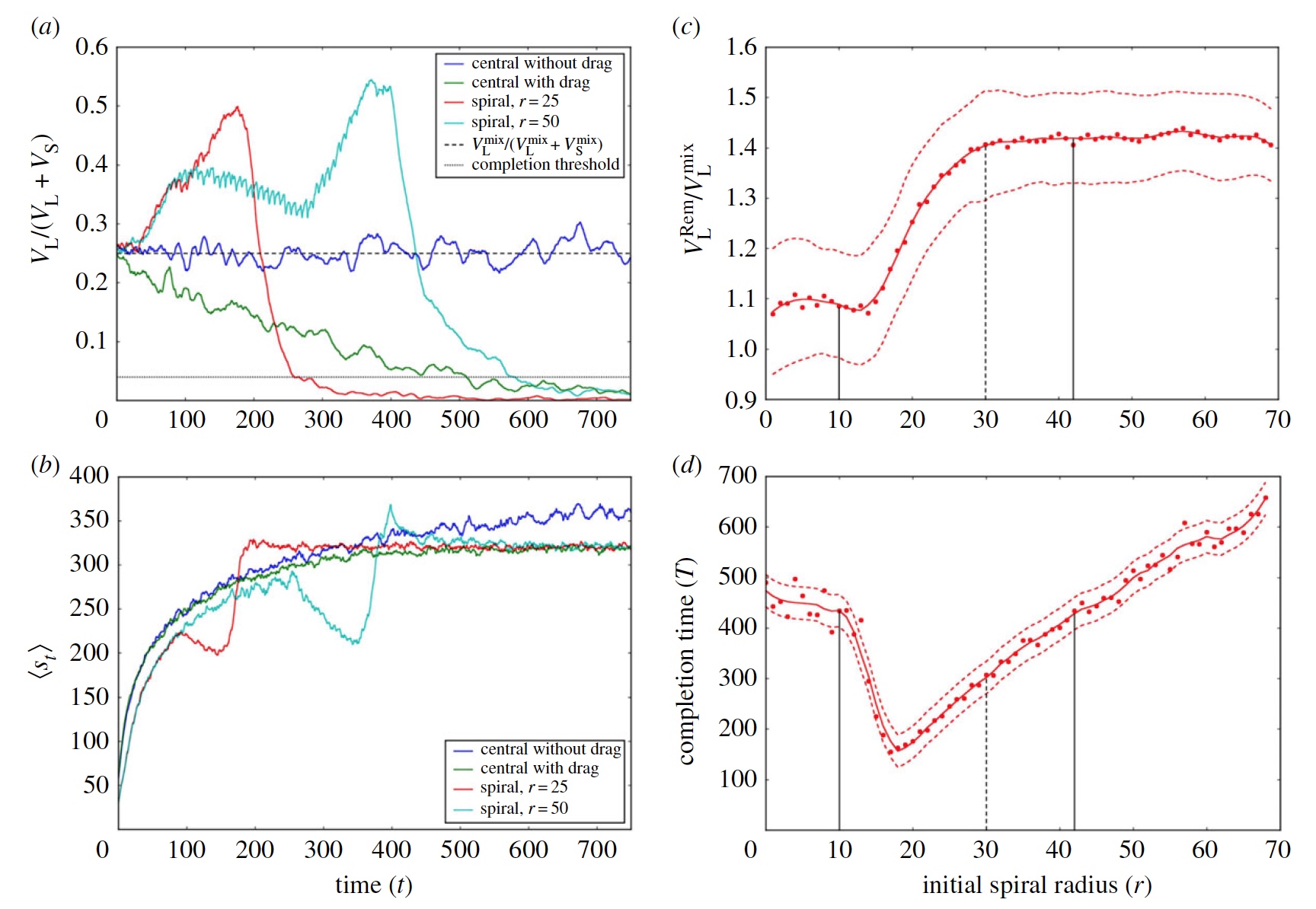
Image No. 4: simulation results.
The first indicator to compare in models and real observation is the number of large grains removed. In the spiral model of large particles upon completion of digging, it became 1.4 times smaller than in the original mixture. It should be noted that centralized models with / without resistance showed a decrease of only 1.05 times. Accordingly, the results of a spiral model are correlated with real observations, which confirms the calculations of the proportionality of large and small grains in the construction of pit traps.
The radius of the simulated well was 30 units, which, when scaling is taken into account, is almost identical to the results of larvae observed in a laboratory experiment — 18 mm. It is worth noting the observed average radii at which the removal of large grains is greatly accelerated to achieve a larger radius of the pit (jump in graph 4c ).
Upon completion of construction, the walls of the pit-traps of the larvae are almost completely covered with small grains. This was observed in all models, but only in the spiral this process was faster.
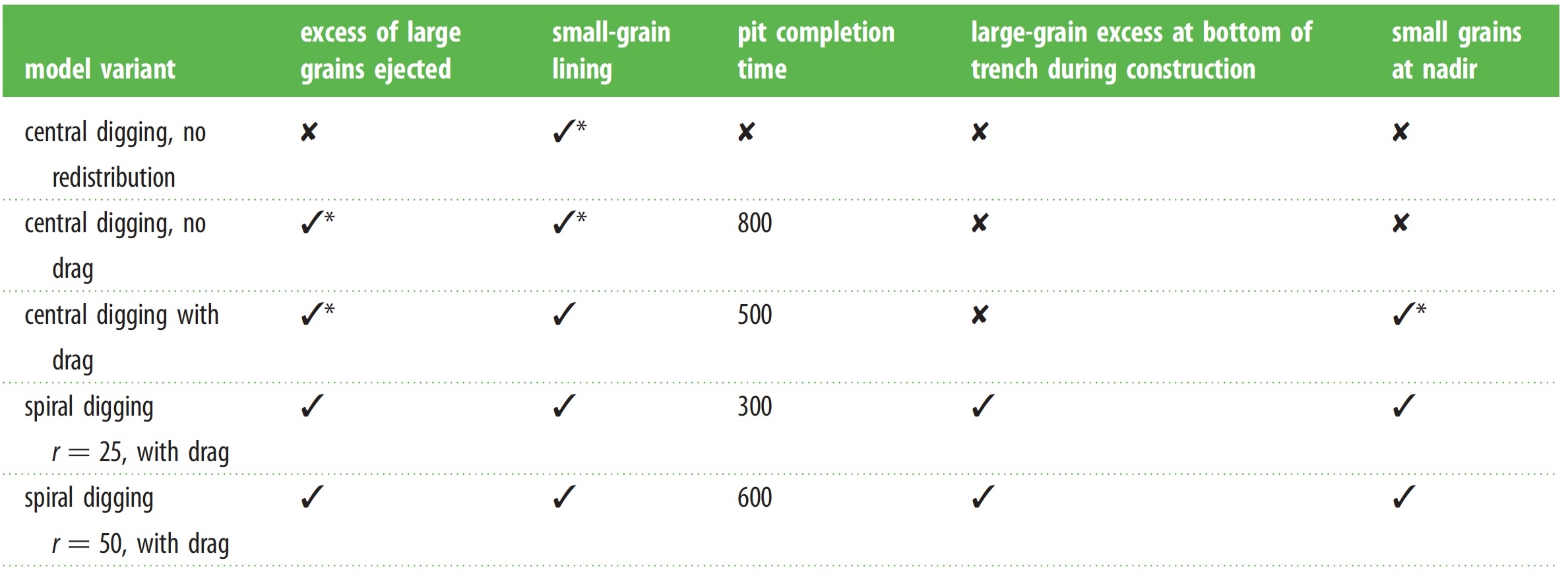
A table comparing the performance of various models described above. As we see, it was the spiral versions of the models that proved to be the most effective.
The ratio between the initial radius (r ≈18), for which the completion time is minimized (strong decline on the 4d chart ), and the final well radius predicted by the model is 0.60.
If we talk about the cost of time, then here the spiral method of digging is better than others. With an initial radius of 25 for the spiral model, it took half the time to complete the pit than other models. A comparison of the data showed that the spiral model reduces the time to complete the pits by 60% with a finite diameter in the range of 10 ... 42 units, i.e. 6-25 mm in reality, which was confirmed by the results of observations in a laboratory experiment.
For a more detailed acquaintance with the nuances of the study, I strongly recommend that you look into the report of the research group .
Epilogue
Sometimes, observing an insect, you think about what is on the mind of this small creature. Does it understand how the world works, is it aware of the physical processes that surround it, does it use them? This study may not answer the question “is it aware?”, But it more than affirmatively answers the question “is it using?”.
Digging a hole is easy, at least at first glance. However, the pit trap should be as efficient as possible, because the life of the person who built it depends on its success. If the ant lion larvae did not use a spiral model of digging, if grains of sand were not sorted, then they would not be able to feed so easily.
Although larvae of ant lions are terrible predators with large stingers, they prefer to use their intelligence as the main and most effective weapon in the struggle for life in the harsh conditions of the wild. True, without the huge stings and dissolving entrails of the victim, the poison would have been more difficult for them.
Friday off-top:
A creepy video about how the lion of an ant lion hunts (I would not want to be in the place of an unfortunate ant).
A creepy video about how the lion of an ant lion hunts (I would not want to be in the place of an unfortunate ant).
Old school nostalgic off-top 2.0:
I think many of you have guessed which product of the gaming industry there is a reference to in the title of this article. The ant lions there were larger and more dangerous than the real ones, but I did not remember the chapter with their participation as much as the chapter “We Do Not Go to Ravenholm”, from which I always have goose bumps.
Thanks for watching, stay curious and have a great weekend everyone, guys.
I think many of you have guessed which product of the gaming industry there is a reference to in the title of this article. The ant lions there were larger and more dangerous than the real ones, but I did not remember the chapter with their participation as much as the chapter “We Do Not Go to Ravenholm”, from which I always have goose bumps.
Thanks for watching, stay curious and have a great weekend everyone, guys.
Thank you for staying with us. Do you like our articles? Want to see more interesting materials? Support us by placing an order or recommending it to your friends, a 30% discount for Habr users on a unique analogue of entry-level servers that we invented for you: The whole truth about VPS (KVM) E5-2650 v4 (6 Cores) 10GB DDR4 240GB SSD 1Gbps from $ 20 or how to divide the server? (options are available with RAID1 and RAID10, up to 24 cores and up to 40GB DDR4).
VPS (KVM) E5-2650 v4 (6 Cores) 10GB DDR4 240GB SSD 1Gbps until the summer for free when paying for a period of six months, you can order here .
Dell R730xd 2 times cheaper? Only we have 2 x Intel Dodeca-Core Xeon E5-2650v4 128GB DDR4 6x480GB SSD 1Gbps 100 TV from $ 249in the Netherlands and the USA! Read about How to Build Infrastructure Bldg. class using Dell R730xd E5-2650 v4 servers costing 9,000 euros for a penny?
